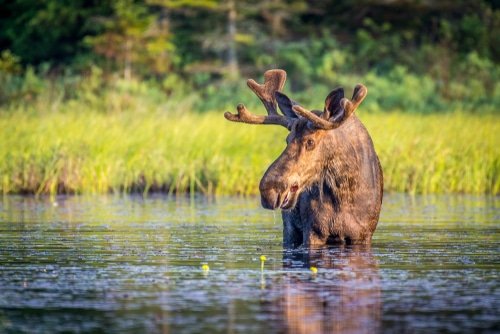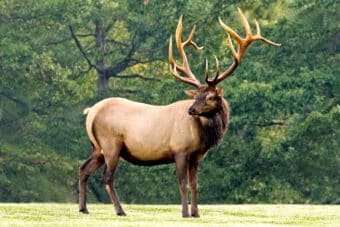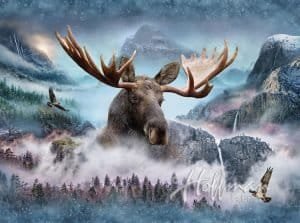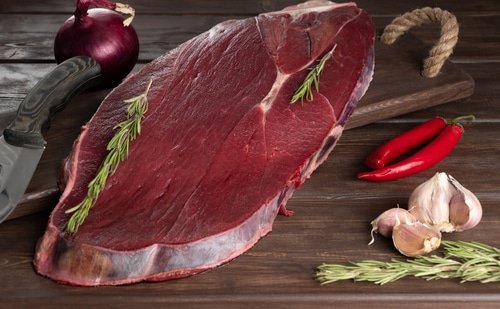Welcome, young adventurers, to the fascinating world of moose! In this educational moose guide, we will embark on an exciting journey into the realm of one of nature’s most majestic creatures. We call it moose facts for kids. So, what exactly is a moose?
Well, my curious friends, a moose is a magnificent and mighty animal that belongs to the deer family. With their towering stature and impressive antlers, they are truly a sight to behold.
What is a moose?
A moose (Alces alces) is a large herbivorous mammal that inhabits the northern regions of North America, Europe, and Asia. These gentle giants can reach incredible heights, up to 6 feet at the shoulder! They have long legs that help them easily navigate various terrains, such as dense forests and marshy wetlands.
Where do moose live?
Moose have an affinity for cool climates and are commonly found in countries like Canada, Sweden, Norway, Russia, and Alaska. They prefer living in areas with abundant vegetation, like deciduous or coniferous forests close to lakes or marshes, where they can find their favorite meal – aquatic plants! Moose are well adapted for life in these regions with thick fur coats that provide insulation from harsh weather conditions.
Why are they called “moose”?
The word “moose” may seem peculiar initially, but it has an interesting origin. It comes from the Algonquian language spoken by Native American tribes who lived in North America.
In their language, it meant “twig eater” or “he strips off.” This name perfectly captures one of the primary aspects of the moose’s diet – their love for munching on twigs and leaves! Now that we have been introduced to the enchanting world of moose let us delve deeper into their captivating facts and explore the wonders of these magnificent creatures!
Moose Appearance
Size and Weight of Moose
When it comes to size, moose are the giants of the deer family. They are the largest land animals in North America!
A fully grown moose can reach a towering height of around 6 to 7.5 feet at the shoulder. And when it comes to weight, these majestic creatures are not lightweight either.
A male moose, also known as a bull moose, can weigh anywhere between 1,200 to 1,600 pounds, while female moos,e called cows, typically range from 800 to 1,300 pounds. That’s heavier than a small car!
Antlers – The Magnificent Crowns of Male Moose
One of the most striking features of male moose is their impressive antlers. These majestic crowns set them apart from their female counterparts. Antlers are bony structures that grow and branch out from the skull of a male moose every year!
They start growing in springtime and continue growing throughout summer. By autumn, their antlers will be fully developed and ready for action.
How Antlers Grow and Shed Each Year
The growth process of antlers is truly fascinating! In springtime or early summer, tiny bumps known as “antler buds” appear on the foreheads of male moose. Over time, these buds develop into cartilage-covered spikes or “velvet-covered antlers.” Blood vessels nourish these antlers as they grow rapidly during this period.
Once autumn rolls around, something interesting happens: male moose rub off the velvet covering on trees and branches to reveal their beautifully formed solid antlers underneath. This behavior helps shed away any remaining velvet and strengthens the antlers for their primary purpose.
The Purpose of Antlers in Attracting Mates
Those magnificent antlers’ primary function is attracting mates during the mating season, also known as the rut. Male moose use their antlers to impress female moose and intimidate other males.
They engage in fierce battles, clashing their antlers together to establish dominance and win the attention of potential mates. These contests can be quite intense and are a sight to behold!
So, next time you spot a moose with impressive antlers, remember they aren’t just for show. They play a vital role in the ceremonial dance of courtship and ensure the survival of these enchanting creatures.
Moose Diet and Eating Habits
Favorite Foods of Moose – Plants, Twigs, and Leaves
When it comes to dining, moose have a rather unique palate. These gentle giants are herbivores, which means they solely feast on plants, twigs, and leaves.
They are particularly fond of aquatic vegetation like water lilies and pondweed. In the summer months, moose munch on tender grasses found near lakes or rivers.
As autumn approaches and the temperatures drop, they shift their attention to shrubs and tree branches. It’s like having their own gourmet buffet right in the wilderness!
How Much Do They Eat in a Day?
Moose sure have an impressive appetite! On average, an adult moose can consume around 40-60 pounds (18-27 kilograms) of vegetation each day! That’s equivalent to gobbling up four large bags of potatoes!
To fuel their massive bodies and maintain their energy levels, these majestic creatures need to keep chowing down throughout the day. They’re pretty much professional eaters!
Unique Digestive System That Helps Them Break Down Tough Vegetation
To tackle their leafy feast effectively, moose possess a remarkable digestive system that sets them apart from other animals. While most herbivores only have one stomach chamber for digestion, moose boast not one or two but four stomach chambers called rumens!
This allows them to break down tough plant matter with ease. Once consumed, the food undergoes a complex process where bacteria in their rumen help ferment the cellulose-rich plants into more digestible substances.
Talk about having an army of helpful gut bacteria! So there you have it—an appetizing insight into the dietary habits of these magnificent creatures.
Moose truly know how to enjoy a vegetarian feast while simultaneously maintaining a healthy lifestyle in the wild. The next time you spot a moose during your nature adventures, you’ll appreciate the importance of their plant-based diet and their incredible digestive system that allows them to thrive in their natural habitat.
Moose Family Life
Social Structure – Solitary or Group Animals?
When it comes to social structure, moose are quite interesting creatures, my young friends! They are generally known as solitary animals, which means they prefer to live alone rather than in groups. However, during certain times of the year, such as mating season and winter months when food is scarce, moose may form small groups called “cow-calf groups.” These consist of a mother moose (called a cow) and her calves.
It’s like a little family reunion! But once the calves grow up and become independent, they venture off on their own into the wild.
The Life Cycle of a Moose from Birth to Adulthood
Let’s take a journey through the life cycle of these magnificent creatures. It all begins with a newborn calf taking its first steps into the world!
Baby moose, also known as calves, are born in early spring when everything starts blooming. They weigh around 25-30 pounds and have reddish-brown fur with white spots that help them blend into their surroundings—how clever!
As they grow up, their fur darkens to match that of adult moose. Over time, young moose gain strength and develop into adults.
Calves – Adorable Baby Moose Facts!
Oh my dear readers, let me tell you about these adorable baby moose! Calves are absolutely delightful creatures.
When they are born, their long wobbly legs make them look like little Bambi characters bouncing around in the forest. Isn’t that adorable?
Their large ears help them listen for any potential danger while exploring their surroundings. And guess what?
Baby moose love munching on plants and twigs right from the moment they arrive in this world! As they grow bigger and stronger day by day, they become more adventurous and start exploring the wilderness alongside their mothers.
Mothers’ Protective Instincts
Now, my curious young minds, let’s talk about the superpower of moose moms. These mothers have fierce protective instincts when it comes to their calves.
They are extremely caring and will do everything in their power to keep their little ones safe from predators. Mothers teach their calves essential survival skills, such as finding food and navigating through the dense forest.
They also have a special call to communicate with their babies, which keeps them close and ensures they’re out of harm’s way. So next time you spot a moose mom with her calf, remember how loving and protective she is!
There you have it, my dear readers! A glimpse into the fascinating family life of moose.
Learning about these majestic creatures and their family dynamics gives us a deeper appreciation for the wonders of nature. Stay tuned for more exciting information in this educational moose guide!

Moose Communication and Behavior
Moose Vocalizations – Grunts, Bellows, and Snorts!
Moose are not known for being the most talkative creatures in the animal kingdom, but they have a repertoire of vocalizations used to communicate with one another. These sounds can be unique and fascinating to listen to. There are a few key ones to be aware of when it comes to moose vocalizations.
One common sound you might hear from a moose is the grunt. Grunts are short, deep sounds that moose make when feeling threatened or annoyed.
It’s their way of saying, “Hey, back off!” Another notable vocalization is the one below. Bellows are much louder and more intense than grunts.
Male moose often use bellows during the mating season to attract females and establish dominance over other males. In addition to grunts and bellows, moose also make snorting sounds.
Snorts are quick bursts of air expelled through their nostrils and are often used as an alarm call when they sense danger nearby. Learning about these different vocalizations can help us understand how moose communicate with each other in their natural habitat.
Mating Rituals – Courtship Displays and Fights Between Males
When finding a mate, male moose put on quite a show! During the mating season, known as the rut, males compete for female attention through elaborate courtship displays and even physical fights. To attract females, male moose engage in an impressive display called “rutting.” This involves thrashing their antlers against trees or bushes while emitting loud bellows.
The purpose is twofold – it advertises their masculinity to potential mates while warning off any competing males nearby. A fight may break out if two male moose happen upon each other during the rut and both have their eyes on the same female.
These fights can be intense and involve locking antlers and pushing against one another with great force. The goal is to establish dominance and secure mating rights.
While these battles may seem fierce, they are rarely lethal, as moose have adapted to withstand such encounters. The stronger and more dominant male typically wins the fight and earns the opportunity to woo the female.
Understanding these courtship displays and male fights provides valuable insight into moose behavior during the breeding season. It showcases their determination to find a mate and ensures that only the strongest males pass on their genes, contributing to the diversity and resilience of moose populations.
So there you have it – a glimpse into the fascinating world of moose communication and behavior! From grunts to bellows and courtship displays to epic fights, learning about moose life adds another wonder to our educational moose guide.
Moose Adaptations for Survival
Camouflaged coat for blending into the environment
One of the most fascinating features of moose is their incredible camouflage. Their coats are perfectly designed to blend seamlessly into their surroundings, making them masters of disguise in the forest.
The coloration of a moose’s fur can vary depending on its habitat, but it usually ranges from dark brown to a rusty reddish-brown. This allows them to blend in with the trees and vegetation surrounding them.
The texture of their fur also helps with camouflage, as it is long and shaggy, providing additional cover when they stand still amidst tall grass or shrubs. So, next time you’re out exploring in the wilderness, keep an eye out for these cleverly disguised giants!
Long legs for wading through deep water or snow
Moose are well-known for their impressively long legs, and these limbs serve them well in their habitats. Their long legs are specifically adapted to help them navigate various terrains such as deep water or heavy snow.
Moose use their powerful legs to wade through the water effortlessly in regions with marshes or lakes. These lengthy limbs also come in handy during snowy winters when they must traverse deep snowdrifts without sinking too much.
The length of their legs gives them an advantage in mobility and survival in challenging environments. By understanding these remarkable adaptations of moose, we gain a deeper appreciation for how they have evolved to thrive in their natural habitats.
From their hidden coats that aid them in blending seamlessly into the forest to their long legs that allow them to conquer any terrain, moose are magnificent creatures deserving our admiration and protection. Remember, kids, sharing this educational moose guide with your friends will help spread knowledge about these fascinating animals, and together, we can become champions for moose conservation!
Moose Fun Facts
Their Swimming Skills – How Far Can They Swim?
When it comes to aquatic abilities, moose are surprisingly adept swimmers! Despite their large size and seemingly cumbersome build, these majestic creatures can swim up to six miles per hour. That’s about as fast as an average human swimmer!
Moose have unique adaptations for swimming, such as their long legs and hollow hair that help with buoyancy. Their broad, paddle-like hooves act like flippers, allowing them to glide through the water effortlessly.
This ability is handy when they must cross rivers and lakes while searching for food or escaping predators. So next time you see a moose taking a dip in the water, remember that they are not just land-dwellers but also skilled swimmers!
Their Speed on Land Despite Their Large Size
Contrary to popular belief, moose may appear slow due to their substantial stature, but they can be surprisingly swift on land! While not known for their agility like smaller animals such as deer or antelope, moose can reach up to 35 miles per hour when running at full tilt.
Imagine the sight of these magnificent creatures galloping through the wilderness! Their long legs provide impressive strides, allowing them to cover considerable ground quickly.
However, despite this surprising speed for their size, moose still prefer a leisurely pace most of the time as they graze on vegetation and explore their habitat. Learning about the versatility of these gentle giants is truly awe-inspiring!
Moose are more than just majestic creatures with impressive antlers; they possess incredible water and land abilities. Their swimming skills enable them to navigate bodies of water effortlessly while traveling long distances for food or safety.
Despite their massive frames, moose exhibit surprising bursts of speed when needed, showcasing a remarkable blend of strength and grace. These fun facts about moose add to the educational moose guide, emphasizing the importance of understanding and appreciating the wonders of nature’s fascinating creations.
Conservation Efforts for Moose
Challenges faced by moose populations today
Moose populations are facing various challenges in the wild, making it crucial to take conservation efforts seriously. One significant challenge is habitat loss.
As human activities expand and infringe upon their natural habitats, moose often lose access to the resources they need for survival, such as food and shelter. Climate change also poses a threat to these majestic creatures.
Rising temperatures affect their habitats by altering vegetation growth patterns and increasing the prevalence of parasites and diseases that can harm them. Additionally, predation from natural predators like wolves and bears can impact moose populations, especially when their numbers are already low due to other factors.
What can we do to help protect them?
As responsible caretakers of our environment, there are several actions we can take to help protect moose populations. First and foremost, spreading awareness is essential. Educating ourselves and others about the importance of preserving these magnificent creatures through books or online resources can significantly impact conservation efforts.
Supporting organizations dedicated to wildlife conservation is another effective way to contribute. Donating money or volunteering time can aid in funding research projects, habitat restoration initiatives, and efforts to reduce human-wildlife conflict.
Additionally, advocating for policies protecting natural habitats from excessive development is crucial for preserving the homes of moose and all wildlife species. By collectively working towards preserving their habitats and respecting their existence in nature’s delicate balance, we ensure future generations can enjoy these remarkable animals—an educational moose guide come alive!
Conclusion: Fascinating Creatures of the Northwoods
The Majesty of Moose
Learning about moose has been an incredible journey through the wilderness of knowledge. These majestic creatures are truly fascinating, captivating our hearts with their enchanting presence in the Northwoods. From their impressive size and weight to their magnificent antlers, moose stands out as one of nature’s most remarkable creations.
A World of Flora and Fauna
Exploring the habitat of moose opens up a world filled with vibrant flora and fauna. We discovered that these herbivores have a diverse diet, munching on plants, twigs, and leaves.
Their unique digestive system allows them to break down tough vegetation efficiently. By understanding how they interact with their environment through feeding habits, we can appreciate the delicate balance of nature.
Preserving Nature’s Treasures for Future Generations
As we conclude our educational moose guide, reflecting on our role in conservation efforts is crucial. Moose populations face challenges today due to habitat loss and climate change. However, there is hope!
By raising awareness about these magnificent creatures and supporting organizations dedicated to protecting their habitats, we can ensure that future generations will also be privileged to witness these awe-inspiring animals in the wild. Learning about moose has enlightened us about their unique characteristics and deepened our appreciation for nature’s wonders.
The more we understand and cherish these gentle giants of the Northwoods, the better equipped we are to preserve and safeguard their habitats for generations. So, let us continue spreading knowledge about these amazing animals as we strive towards a brighter future for moose and all other magnificent creatures that share this beautiful planet with us!






